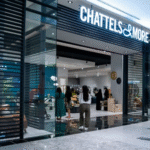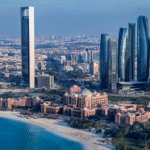Now Reading: What Are the New Tax Changes for Dubai Real Estate Investors?
-
01
What Are the New Tax Changes for Dubai Real Estate Investors?
What Are the New Tax Changes for Dubai Real Estate Investors?

Table of Contents
Tax Changes: Picture yourself owning a sleek waterfront apartment in Dubai Marina or a sprawling villa on Palm Jumeirah, with rental income flowing in, untouched by heavy taxes, and your investment growing in a city that’s a global magnet for wealth. In 2025, Dubai’s real estate market continues to dazzle foreign investors with 100% freehold ownership, a stable dirham pegged to the U.S. dollar, and a tax-friendly environment that outshines hubs like London or New York.
With 58% of buyers from countries like the UK, India, and Russia driving 94,000 property transactions in the first half of 2025, the emirate’s 4-6% rental yields and 8-12% price appreciation outpace global averages. Properties over $545,000 qualify for a 10-year Golden Visa, while smaller units offer 2-year residency perks.
Recent tax changes, including the Domestic Minimum Top-up Tax (DMTT) and updates to Qualifying Investment Funds (QIFs), are reshaping the landscape for investors. This guide dives into these changes, spotlighting projects like Dubai Marina Coastal Towers and Palm Jumeirah Ocean Villas, to help you navigate the tax perks and maximize your wealth in Dubai’s thriving market.
Dubai’s Tax-Friendly Legacy for Real Estate Investors
Dubai’s real estate market has long been a haven for investors, thanks to zero personal income tax, no capital gains tax, and no annual property taxes. A $2 million property yielding 5% ($100,000 annually) remains tax-free for individual landlords, versus $55,000-$70,000 after taxes in the U.S. or UK. Selling a property for a $500,000 profit saves $100,000-$140,000 in capital gains tax compared to global hubs.
Residential purchases dodge 5% VAT, saving $100,000 on a $2 million home, unlike commercial properties or the UK’s stamp duty (up to 12%). The 9% corporate tax, introduced in 2023, spares individual landlords, and small business relief waives it for revenues under $816,000 until December 31, 2026.
With a 5% population surge and 25 million tourists fueling demand, Dubai’s low vacancy rates (2-3%) make it a prime investment destination. New tax changes in 2025 refine this landscape, balancing global compliance with investor-friendly policies.
The tax-free allure feels like a golden opportunity to grow wealth effortlessly.
New Tax Change 1: Domestic Minimum Top-up Tax (DMTT)
Starting January 1, 2025, the UAE introduces the Domestic Minimum Top-up Tax (DMTT), a 15% tax targeting multinational enterprises (MNEs) with global revenues exceeding €750 million ($793 million). This aligns with the OECD’s Two-Pillar Solution, ensuring large corporations contribute fairly to the global tax system. For real estate investors, the DMTT impacts those operating through corporate structures, such as companies managing multiple properties.
A company leasing 10 apartments with $1 million in annual rental income now faces a 15% tax ($150,000) if it qualifies as an MNE, reducing net returns from $1 million to $850,000. Individual investors and smaller entities with revenues below $816,000 remain unaffected, preserving Dubai’s tax-free appeal for most.
Free zone companies, like those in Dubai Multi Commodities Centre (DMCC), can avoid DMTT by meeting Qualified Free Zone Person (QFZP) criteria, saving $12,240-$61,200 on $122,400-$612,000 in income. Setup costs for a QFZP are $2,000-$5,000, with annual fees of $1,000-$3,000.
This change feels like a nudge for big players to contribute, while small investors thrive.
New Tax Change 2: Qualifying Investment Fund (QIF) Exemptions
Cabinet Decision No. 34 of 2025, effective Q2 2025, refines tax rules for Qualifying Investment Funds (QIFs) and Real Estate Investment Trusts (REITs). QIFs, including those investing in real estate, remain exempt from corporate tax if they meet specific criteria: no more than 10% of income from real estate assets and diverse ownership to avoid concentrated control.
If a QIF exceeds the 10% real estate income threshold, 80% of that income faces the 9% corporate tax. For example, a QIF earning $1 million, with $200,000 from real estate, sees $160,000 taxed at 9% ($14,400). This encourages diversified funds while maintaining tax benefits for compliant investors.
REITs heavily invested in Dubai properties, like those in Bluewaters Azure Residences, must reassess structures to stay exempt. Investors using QIFs for properties like Jumeirah Bay Pearl Lofts can save $10,000-$50,000 annually by ensuring compliance, with legal restructuring costs of $1,500-$4,000.
These exemptions feel like a smart way to keep returns high for savvy investors.
New Tax Change 3: Enhanced Free Zone Benefits
Free zones like DMCC, Dubai Internet City, and Dubai Silicon Oasis continue to offer tax advantages in 2025. Companies registered as QFZPs enjoy 0% corporate tax, provided they don’t conduct business with mainland UAE and meet substance requirements (e.g., local staff and operations). A QFZP managing a $3 million Dubai Islands Horizon Villa yielding $120,000-$180,000 annually saves $10,800-$16,200 in taxes.
Small business relief extends to free zone entities with revenues under $816,000 until 2026, sparing them the 9% corporate tax. For instance, a free zone company leasing a $1.2 million Dubai Marina Coastal Tower saves $4,320-$6,480 on $48,000-$72,000 in rental income. Setup costs ($2,000-$5,000) and annual fees ($1,000-$3,000) are offset by tax savings, making free zones ideal for foreign investors managing multiple properties.
The free zone perks feel like a secret weapon for maximizing profits.
New Tax Change 4: VAT Framework Updates
The 5% VAT, in place since 2018, remains unchanged in 2025, but compliance requirements are tightening. Residential purchases, like a $2 million Bluewaters Azure Residence, are VAT-exempt, saving $100,000, unlike commercial properties. Off-plan purchases may incur 5% VAT on developer fees ($20,000-$80,000), recoverable via Federal Tax Authority (FTA) registration ($500-$1,000).
Short-term rental operators, leveraging platforms like Airbnb, must register for VAT if annual revenue exceeds $102,041, charging 5% on bookings but claiming input tax credits on expenses like utilities or DTCM fees ($408-$816 annually). For a $4 million Palm Jumeirah Ocean Villa yielding $160,000-$240,000, VAT registration adds $8,000-$12,000 in tax but allows credits of $2,000-$5,000. Non-compliance risks fines up to $13,612, so investors must ensure proper bookkeeping.
The VAT structure feels manageable with the right planning and expert advice.
Spotlight: Dubai Marina Coastal Towers
Dubai Marina Coastal Towers by Emaar, set for completion in Q3 2025, offer 1-3 bedroom apartments ($816,750-$2.04 million) with 4-6% rental yields and 8-12% price growth. A $1.2 million apartment yields $48,000-$72,000 tax-free for individuals, versus $26,400-$43,200 elsewhere.
Selling it for $1.5 million after 25% appreciation yields a $300,000 tax-free profit, saving $60,000-$84,000. No property taxes save $12,000-$24,000 yearly, and VAT exemption saves $60,000. A QFZP saves $4,320-$6,480 annually, but DMTT applies to MNEs. Initial costs include a 4% DLD fee ($48,000), 2% broker fee ($24,000), and a 50/50 payment plan. Maintenance fees are $5,000-$12,000, with a 5% municipality fee ($2,400-$3,600). Golden Visa eligibility applies, and short-term rentals boost yields by 10-20%.
The urban vibe feels like a dynamic, tax-smart investment hub.
Spotlight: Palm Jumeirah Ocean Villas
Palm Jumeirah Ocean Villas by Nakheel, set for completion in Q2 2025, offer 4-6 bedroom villas ($3 million-$6 million) with 4-6% rental yields and 8-12% price growth. A $4 million villa yields $160,000-$240,000 tax-free, versus $88,000-$144,000 elsewhere. Selling it for $5 million yields a $1 million tax-free profit, saving $200,000-$280,000.
No property taxes save $40,000-$80,000 yearly, and VAT exemption saves $200,000. A QFZP saves $14,400-$21,600, but DMTT applies to MNEs. Initial costs include a 4% DLD fee ($120,000-$240,000), 2% broker fee ($60,000-$120,000), and a 20/50/30 payment plan. Maintenance fees are $15,000-$25,000, with a 5% municipality fee ($8,000-$12,000). Golden Visa eligibility applies, and short-term rentals boost yields by 10-20%.
The beachfront luxury feels like a prestigious, high-return haven.
Impact on Individual Investors
Individual investors, particularly those holding properties directly, remain largely unaffected by 2025’s tax changes. The absence of personal income tax, capital gains tax, and annual property taxes ensures a $1.2 million Dubai Marina Coastal Tower yielding $48,000-$72,000 keeps every dirham. U.S. investors can deduct depreciation ($21,818-$43,636) and management fees ($2,236-$5,091) on Schedule E, saving up to $17,455 annually. Non-U.S. investors benefit from double taxation treaties with 130+ countries, avoiding taxes like the UK’s 20-28% capital gains tax. Long-term leases require Ejari registration ($54-$136 annually), while short-term rentals need DTCM registration ($408-$816). The tax-free framework feels like a financial gift for individual landlords.
Impact on Corporate Investors
Corporate investors face the DMTT if they qualify as MNEs, impacting returns on large portfolios. A company managing $10 million in properties with $500,000 in rental income faces a 15% tax ($75,000), reducing net income to $425,000. QIFs exceeding the 10% real estate income threshold lose partial exemptions, with 80% of real estate income taxed at 9%.
Free zone companies avoid taxes by meeting QFZP criteria, but non-compliance risks fines up to $136,125. Restructuring to QIF or QFZP status costs $1,500-$5,000 but saves $10,000-$50,000 annually. Corporate investors must weigh compliance costs against tax savings, making expert guidance essential.
The corporate changes feel like a call to strategize smarter.
Costs of Ownership in 2025
Buying a $2 million property incurs a 4% DLD fee ($80,000), 2% broker fee ($40,000), and a 10% deposit ($200,000). Flexible payment plans (50/50 or 20/50/30) spread costs, with 50-70% paid during construction. Annual maintenance fees range from $5,000-$25,000, and landlords pay a 5% municipality fee ($2,400-$12,000). Off-plan purchases may incur 5% VAT ($20,000-$80,000), recoverable via FTA registration. Short-term rentals require DTCM registration ($408-$816), while long-term leases need Ejari registration ($54-$136). Gift transfers to shareholders reduce DLD fees to 0.125% ($2,500 for a $2 million property), saving $77,500.
These costs feel like a small price for tax-free wealth-building.
Strategies to Navigate the New Tax Landscape
To maximize returns, adopt these strategies. First, hold properties as an individual to avoid DMTT and corporate tax. Second, use QFZP free zone companies for portfolios, saving $10,000-$50,000 annually. Third, ensure QIFs stay under the 10% real estate income threshold to maintain exemptions. Fourth, recover 5% VAT on off-plan purchases via FTA registration.
Fifth, leverage small business relief for revenues under $816,000 until 2026. Sixth, U.S. investors should deduct depreciation and expenses on Schedule E. Hire a property manager ($5,000-$25,000 annually) and consult tax professionals to ensure compliance and avoid fines up to $136,125.
Mitigating Risks in 2025
Risks include a projected oversupply of 41,000 units, potentially slowing price growth. Mitigate by choosing trusted developers like Emaar or Nakheel, verifying escrow compliance under the 2025 Oqood system, and targeting high-demand projects with 2-3% vacancy rates. Monitor FTA announcements for DMTT and QIF updates. Short-term rentals in Dubai Marina boost yields by 10-20%, while long-term leases in Palm Jumeirah ensure stability. Diversify across locations like Bluewaters or Jumeirah Bay to spread risk. Regular market analysis keeps you ahead.
Why Dubai Remains a Top Choice
Despite new tax changes, Dubai’s real estate market shines in 2025. Individual investors enjoy untouched tax-free rentals, capital gains, and no property taxes, while corporate investors can leverage QFZP and QIF structures to minimize liabilities. Projects like Dubai Marina Coastal Towers and Palm Jumeirah Ocean Villas offer 4-6% yields, 8-12% price growth, and Golden Visa perks. The DMTT and QIF rules target large MNEs, leaving most investors unaffected. With a stable economy, 25 million tourists, and investor-friendly policies, Dubai feels like a vibrant, tax-smart haven for building wealth.
read more: Dubai Waterfront Homes: 6 Tax Advantages Foreigners Are Using






















